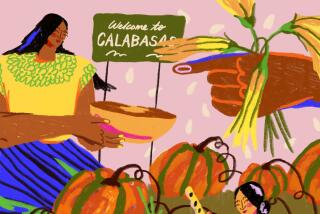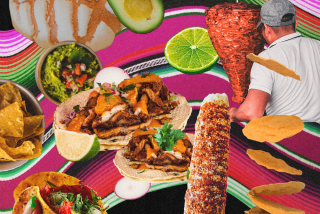Pop Culture
- Share via
I’m listening to my stovetop.
I have carefully poured enough cooking oil to coat the bottom of a 10-inch saute pan and, after heating it over a medium-high flame, have dumped in the requisite 1/3 cup of popcorn kernels. The aroma of the warming oil is enough to inspire all sorts of Rockwellian feelings. But what really sets the mood is the staccato rhythm produced by those exploding kernels as they ricochet insanely off the lid. It’s like an organic Morse code, and it’s telling me, “Dependable snack on the way. Locate salt. Cue ‘The Big Lebowski.’ ”
Thanks to Jiffy Pop, Orville Redenbacher and the chemical sublimity of the microwave edition, popcorn has acquired an image of jet-age convenience. The kernel of truth is that, of the six basic varieties of maize, popcorn probably was the first to be cultivated--as long ago as 8,000 years.
Early European explorers found popped or parched corn virtually everywhere they marched in the Americas. According to the Popcorn Promotion Board, pre-Incan clay poppers have been found in coastal Peru, and a 1,700-year-old Zapotec funeral urn unearthed in Mexico depicts the god of maize with popcorn in his headdress. When Columbus landed in the West Indies, the board tells us, the residents tried to sell him popcorn.
Most intriguing was an archeological find in 1948. Working in a New Mexico site known as Bat Cave, students from Harvard and the University of New Mexico discovered unpopped kernels that dated to before the time of Christ. Like any good college students, their reaction was, “Dude, let’s cook ‘em!” They did, and the corn popped like hatching dinosaurs. Popcorn shot into the modern age in 1893, when Charles Cretors unveiled his mobile steam-powered popcorn popper at the Columbian Exposition in Chicago. It wasn’t long before the snack became a staple. Today America’s annual per-capita consumption is 68 quarts of popped popcorn.
Other types of corn, and even other grains, can be popped. What makes popcorn ideal for the task is its outer shell, which is hard enough to seal moisture inside. When the water content and heat are just right (roughly 14% and 480 degrees, respectively), the liquid expands, cooking the soft inner starch and eventually bursting through the hull. The kernel turns inside out, blossoming into a crisp white or yellow flower. The water is released as steam, which you should allow to escape.
Popcorn got a bad rap in 1994, when those old maids at the Center for Science in the Public Interest revealed that cinema popcorn cooked in coconut oil contained as much as 80 grams of fat per tub, sans butter.
But you don’t have to cook your corn in coconut oil, and many theaters now agree. Canola oil works just fine. And while buttered popcorn is indeed a delicacy, so are many less-clogging versions. Cayenne pepper, lime, Parmesan cheese, garlic powder--all of them can dress up a simple bowl of popcorn. Feel free to experiment--but never omit the salt. At least that’s what my saute pan tells me.
Cajun Corn
8 cups popped popcorn
2 tablespoons butter
1/2 teaspoon paprika
1/4 teaspoon garlic powder
1/4 teaspoon cayenne pepper
1/2 teaspoon ground black pepper
1/2 teaspoon ground white pepper
1/4 teaspoon Tabasco sauce
Salt to taste
Place the popcorn in a large bowl. Melt the butter in a small pan over low heat, then remove. Stir in the remaining ingredients (except for the salt), drizzle a bit over the popcorn, and mix with a large spoon. Repeat until all of the spice mixture has been used. Salt liberally.
*
Food stylist: Christine Masterson
*
Phil Barber last wrote for the magazine about coconut cream pie.
More to Read
Eat your way across L.A.
Get our weekly Tasting Notes newsletter for reviews, news and more.
You may occasionally receive promotional content from the Los Angeles Times.










